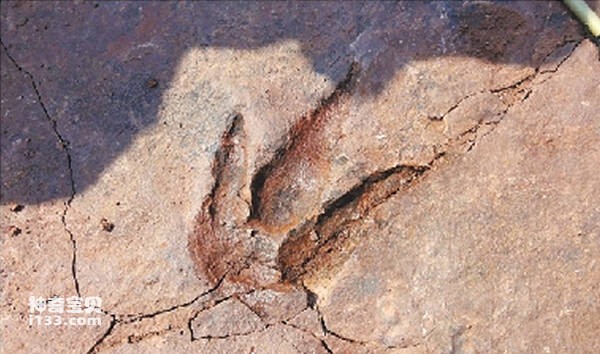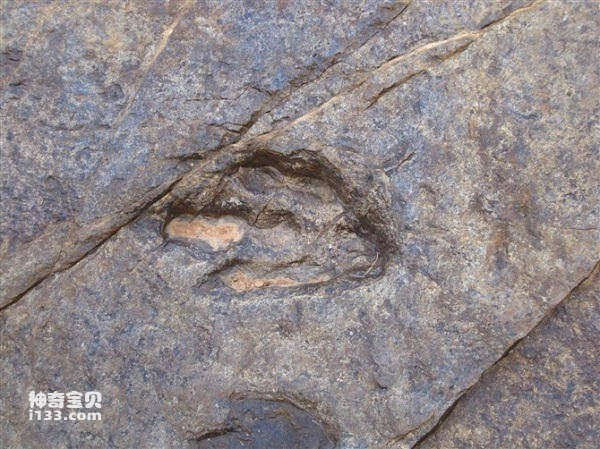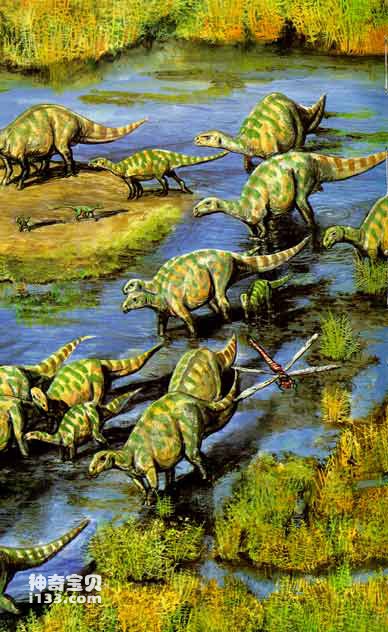At 20 degrees east longitude on the south side of the Arctic Circle, there is a group of remote islands floating lonely in the east of the Greenland Sea, cowering in the biting cold wind. This is the Spitsbergen Islands that no one pays attention to on weekdays.

On August 3, 1960, an expedition team composed of geologists from different countries discovered the footprints of 13 ancient animals on a Cretaceous sandstone cliff on the Spitsbergen Islands. Each footprint is 60-75 centimeters long and clearly has three toes. Among them, 7 footprints are lined up in a line within a distance of 13.5 meters, and other footprints are scattered in all directions.
Scholars almost unanimously judged: "This is a precious footprint left by Iguanodon, one of the most prosperous dinosaurs on the earth 100 million years ago." Soon, the news spread like wildfire, spread all over the world, and became a Breaking news from radio stations and major newspapers.
As we all know, the Mesozoic era was the world of dinosaurs. In the bustling dinosaur kingdom, Iguanodon is one of the various ornithopods. Their body length is generally about 10 meters and their height is about 5 meters; their bodies are bulky and their tails are thick; their forelimbs have 5 fingers with no claws at the end, which is like a "human hand"; they usually stand upright on two feet and walk on two feet, with There are 3 toes. They forage, drink, and roam leisurely in dense jungles, humid swamps, or lakeside. Professor Yang Zhongjian, a famous Chinese paleontologist, also discovered the footprint fossils of Iguanodon in Shenmu County, Shaanxi Province, my country in 1929.

Iguanodon fossils are the earliest dinosaur fossils discovered. Mantell, a British country doctor, collected the first dinosaur fossils from the rock formations on the inside of a newly split road in Sussex, southern England, in March 1822, which were the teeth and bone fossils of Iguanodon.
In the more than 100 years since then, the historical veil of Iguanodon has been gradually unveiled by scientists, and there are no longer many secrets hidden. However, these "close-ups" of Iguanodon left in the Spitsbergen Islands caused a wave of uproar. This is related to the special geographical location of Spitsbergen.
Among the fossil sites where dinosaur remains were found in the past, the closest one to the North Pole is 4,000 kilometers away, while the Spitsbergen Islands are only 1,300 kilometers away from the North Pole. How can it not be astonishing to push the northern limit of the dinosaur distribution area so far north?
Scientists speculate that the Spitsbergen Islands, which today "float" like a boat on the vast sea, must have been connected to the Eurasian continent during the Cretaceous 100 million years ago. Otherwise, birds would How could a dragon be so capable of conquering 700-800 kilometers of sea and landing on the Spitsbergen Islands?
Dinosaurs, like modern reptiles, are "cold-blooded" and cannot regulate their own body temperature. Their body temperature changes with the temperature of their surrounding environment. When the weather is very cold, they will freeze to death quickly, so they can only build their own paradise in tropical and subtropical climate areas. However, today's Spitsbergen Islands are located in the Arctic region, and the climate is extremely cold. If this was the case during the Cretaceous, how did these iguanodons live?
Obviously, the body of Iguanodon is too big to hide underground and hibernate to avoid the harsh winter like crocodiles, snakes, turtles or lizards. So, could it be that the Spitsbergen Islands, where the Iguanodon footprints were discovered, was also an area that was hot all year round?
Many paleontologists and geologists believe that during the Cretaceous, most areas on the earth had a tropical climate, and this warm climate was particularly suitable for dinosaurs to thrive. At that time, from Australia, Africa, to northern Eurasia, there were ideal places for dinosaurs to roam. Even the current Arctic and Antarctic regions of the earth were considered "cool" places at best at that time.
However, a warm climate alone is not enough. Iguanodon is a vegetarian dinosaur that eats a large amount of plant branches and leaves every day to maintain the energy required for its huge body. However, plants cannot grow without the sun, and Spitsbergen Islands are close to the Arctic Circle and cannot see the sun at all for 4 months in winter. So, can the Iguanodon withstand the test of 4 months of starvation? Otherwise, where to find food?

The United Ancient Continents on Triassic Earth
This contradiction may be explained by the theory of continental drift.
During the Triassic period, all the continents today were connected together, called the "United Ancient Continent." Later, the United Ancient Continent split into several land masses. After a long period of drift, each land mass finally moved to its current position.
During the late Cretaceous period, 70 million years ago, the Spitsbergen Islands were part of the Eurasian continent that was drifting northward. When the Iguanodon lived, the Spitsbergen Islands were still relatively south, where there was sufficient sunlight and plants could grow all year round, providing abundant food for the Iguanodon.

Iguanodon life picture
Recently, there is another explanation that has attracted more and more attention from the scientific community, and that is the "polar migration theory." Studies of magnetism in rocks indicate that Earth's poles were not where they are now in geological time. Some scientists believe that in the days when dinosaurs were dominant, the North Pole was located in the north of Siberia, and the latitude of the Spitsbergen Islands was only about 60 degrees north latitude. The latitude is similar to today's Oslo and Stockholm. There is still relatively sufficient sunlight in its south to maintain the growth of plants, and the Iguanodon will have sufficient food sources.
The discovery of the Iguanodon footprints in the Spitsbergen Islands is one of the most interesting and important events in the past 100 years since the discovery of dinosaur fossils. The value of this discovery has long gone beyond the exploration of the species Iguanodon itself. All aspects it involves provide important clues for scientists to understand the earth, environment and biological features 100 million years ago.
animal tags:
We created this article in conjunction with AI technology, then made sure it was fact-checked and edited by a Animals Top editor.